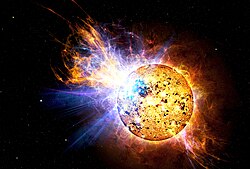EV Lacertae
 Artist's conception of a flare explosion on EV Lacertae. | |
| Observation data Epoch J2000 Equinox J2000 | |
|---|---|
| Constellation | Lacerta |
| Right ascension | 22h 46m 49.7323s[1] |
| Declination | +44° 20′ 02.368″[1] |
| Apparent magnitude (V) | 10.09[2] |
| Characteristics | |
| Spectral type | M3.5[3] |
| U−B color index | +0.83[4] |
| B−V color index | +1.36[4] |
| Variable type | Flare star |
| Astrometry | |
| Radial velocity (Rv) | –1.5[5] km/s |
| Proper motion (μ) | RA: –704.65[1] mas/yr Dec.: –459.41[1] mas/yr |
| Parallax (π) | 197.9573 ± 0.0220[6] mas |
| Distance | 16.476 ± 0.002 ly (5.0516 ± 0.0006 pc) |
| Details | |
| Mass | 0.35[7] M☉ |
| Radius | 0.36[7] R☉ |
| Temperature | 3,400 ± 18[8] K |
| Metallicity [Fe/H] | –0.01 ± 0.17[8] dex |
| Rotation | 4.376 days[9] |
| Rotational velocity (v sin i) | 4.5[7] km/s |
| Other designations | |
GJ 873, BD+43 4305, LHS 3853, LTT 16695, HIP 112460, PLX 5520 | |
| Database references | |
| SIMBAD | data |
EV Lacertae (EV Lac, Gliese 873, HIP 112460) is a faint red dwarf star 16.5 light years away in the constellation Lacerta. It is the nearest star to the Sun in that region of the sky, although with an apparent magnitude of 10, it is only barely visible with binoculars. EV Lacertae is spectral type M3.5 flare star that emits X-rays.[10]
On 25 April 2008, NASA's Swift satellite picked up a record-setting flare from EV Lacertae.[11] This flare was thousands of times more powerful than the largest observed solar flare. Because EV Lacertae is much farther from Earth than the Sun, the flare did not appear as bright as a solar flare. The flare would have been visible to the naked eye if the star had been in an observable part of the night sky at the time. It was the brightest flare ever seen from a star other than the Sun.
EV Lacertae is much younger than that of the Sun. Its age is estimated at 300 million years, and it is still spinning rapidly. The fast spin, together with its convective interior, produces a magnetic field much more powerful than that of the Sun. This strong magnetic field is believed to play a role in the star's ability to produce such bright flares. After the flare, the star was blue.[12]
References[]
- ^ a b c d Perryman, M. A. C.; et al. (April 1997). "The HIPPARCOS Catalogue". Astronomy & Astrophysics. 323: L49–L52. Bibcode:1997A&A...323L..49P.
- ^ "V* EV Lac -- Flare Star". SIMBAD. Centre de Données astronomiques de Strasbourg. Retrieved 2010-06-12.
- ^ Montes, D.; López-Santiago, J.; Gálvez, M. C.; Fernández-Figueroa, M. J.; De Castro, E.; Cornide, M. (November 2001). "Late-type members of young stellar kinematic groups - I. Single stars". Monthly Notices of the Royal Astronomical Society. 328 (1): 45–63. arXiv:astro-ph/0106537. Bibcode:2001MNRAS.328...45M. doi:10.1046/j.1365-8711.2001.04781.x. S2CID 55727428.
- ^ a b Erro, B. I. (1971). "Infrared photometry of UV CET stars". Boletin del Instituto de Tonantzintla. 6: 143. Bibcode:1971BITon...6..143E.
- ^ Wilson, Ralph Elmer (1953). "General Catalogue of Stellar Radial Velocities". Carnegie Institute Washington D.C. Publication. Washington: Carnegie Institution of Washington. Bibcode:1953GCRV..C......0W.
- ^ Brown, A. G. A.; et al. (Gaia collaboration) (2021). "Gaia Early Data Release 3: Summary of the contents and survey properties". Astronomy & Astrophysics. 649: A1. arXiv:2012.01533. Bibcode:2021A&A...649A...1G. doi:10.1051/0004-6361/202039657. S2CID 227254300. Gaia EDR3 record for this source at VizieR.
- ^ a b c Phan-Bao, Ngoc; Martín, Eduardo L.; Donati, Jean-François; Lim, Jeremy (July 2006). "Magnetic Fields in M Dwarfs: Rapid Magnetic Field Variability in EV Lacertae". The Astrophysical Journal. 646 (1): L73–L76. arXiv:astro-ph/0603480. Bibcode:2006ApJ...646L..73P. doi:10.1086/506591. S2CID 18410819.
- ^ a b Rojas-Ayala, Bárbara; et al. (April 2012). "Metallicity and Temperature Indicators in M Dwarf K-band Spectra: Testing New and Updated Calibrations with Observations of 133 Solar Neighborhood M Dwarfs" (PDF). The Astrophysical Journal. 748 (2): 93. arXiv:1112.4567. Bibcode:2012ApJ...748...93R. doi:10.1088/0004-637X/748/2/93. S2CID 41902340.
- ^ Testa, Paola; Drake, Jeremy J.; Peres, Giovanni (December 2004). "The Density of Coronal Plasma in Active Stellar Coronae". The Astrophysical Journal. 617 (1): 508–530. arXiv:astro-ph/0405019. Bibcode:2004ApJ...617..508T. doi:10.1086/422355. S2CID 17532089.
- ^ Schmitt JHMM; Fleming TA; Giampapa MS (Sep 1995). "The X-ray view of the low-mass stars in the solar neighborhood". Astrophys. J. 450 (9): 392–400. Bibcode:1995ApJ...450..392S. doi:10.1086/176149.
- ^ Dunbar, Brian (May 20, 2008). Smith, Yvette (ed.). "Pipsqueak Star Unleashes Monster Flare". NASA. Retrieved 2010-06-12.
- ^ "- YouTube".
- Lacerta (constellation)
- M-type main-sequence stars
- Objects with variable star designations
- Flare stars
- Ursa Major Moving Group
- Hipparcos objects
- Gliese and GJ objects